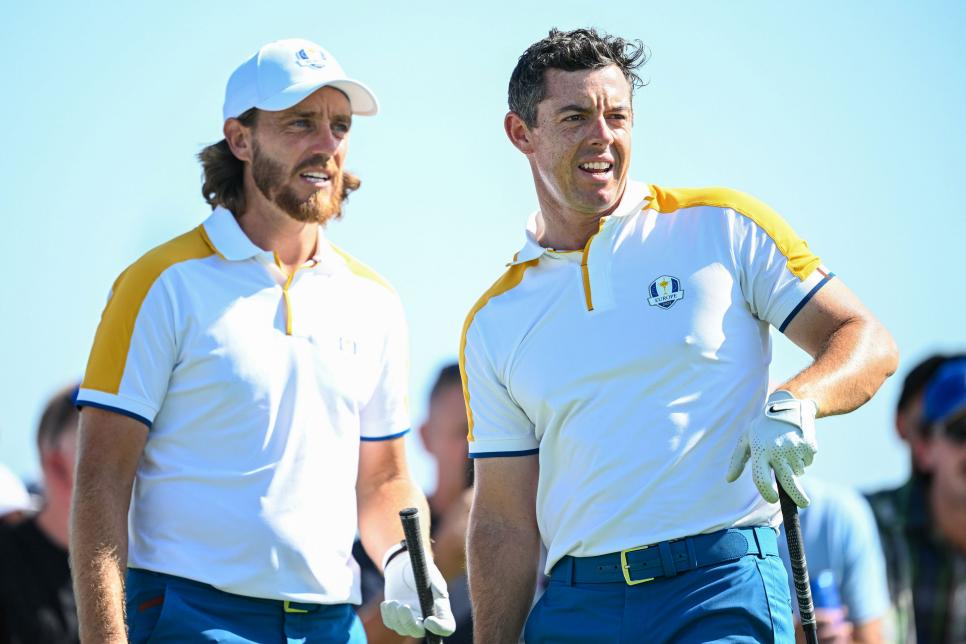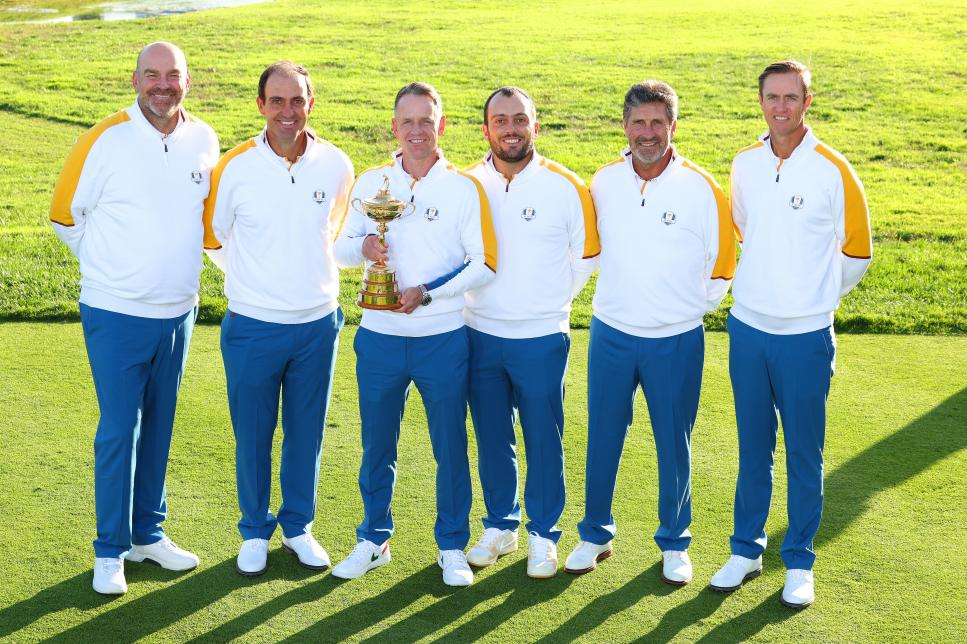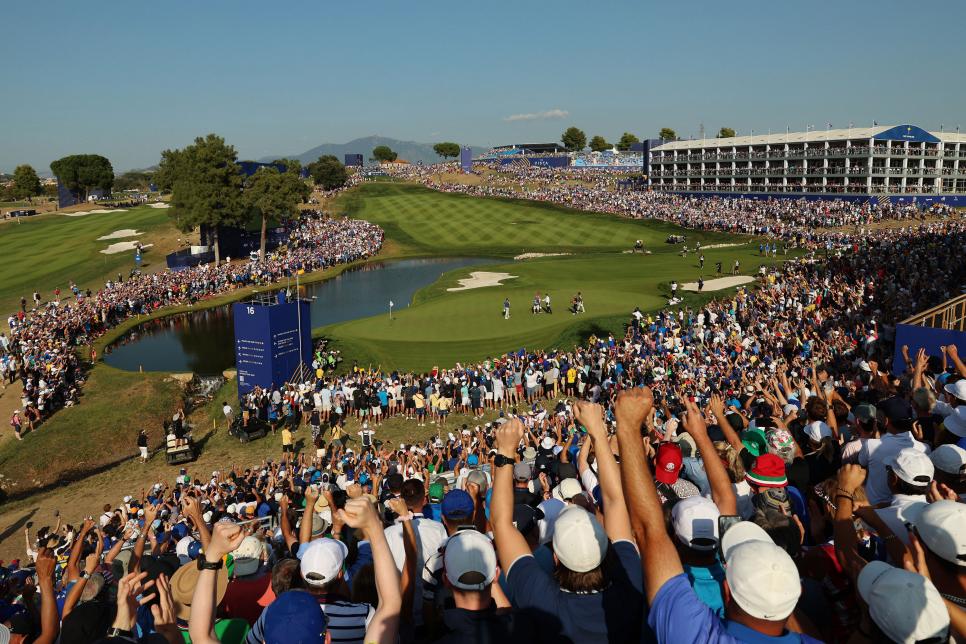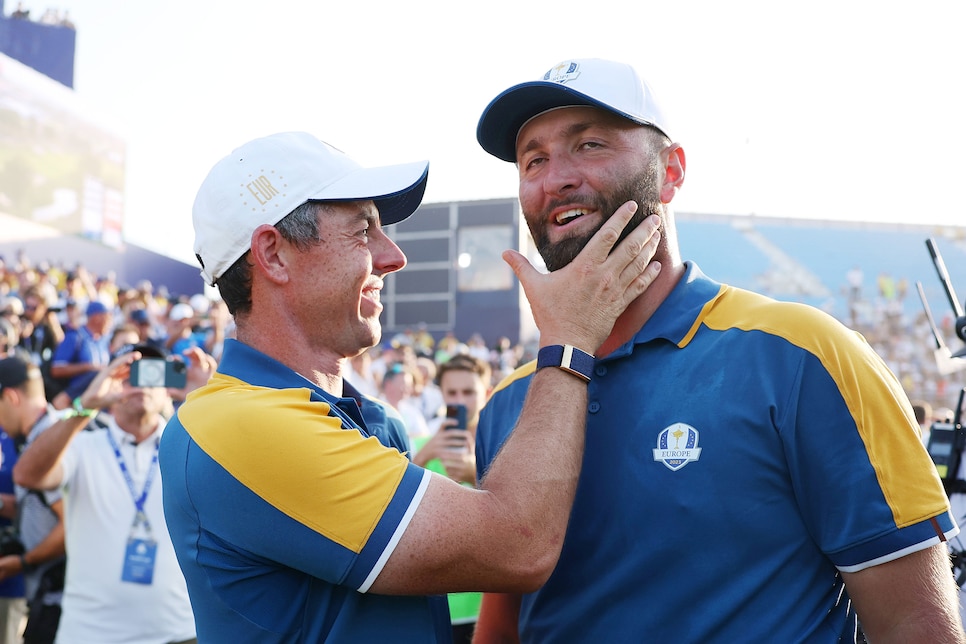In the face of the obvious truth that European golfers were much better at executing their shots than the Americans over the past three days at Marco Simone, it’s time now to take stock of the latest home blowout in the Ryder Cup and ask the deeper “why?”
Here are seven critical reasons the Europeans managed to seize control of the competition on Friday, and—despite a brief moment of tension on Sunday afternoon—kept that control for the entire weekend.
1. They controlled the first hole
In the first three sessions of play, after which the Europeans led 9½-2½ and the outcome of the Cup was all decided, the home side had won the opening hole in five of the 12 matches. More astoundingly, the Americans won it zero times. That’s more important than you might think; teams that lead early win more often than they lose, to state the obvious. Those holes establish momentum and put pressure on the opponent. After the first hole, no European team trailed in those three critical sessions, and five of them led. The final tally after singles was Europe with 10 wins on the first hole, and America with just four.
You could explain this in a couple ways. Americans may have gotten into trouble with riskier club selection, or maybe Luke Donald’s policy of having his team play three-hole practice matches payed off. Maybe the set-up benefited them—we heard endlessly on the TV broadcast that certain distances (180 yards was mentioned often) gave the Europeans an advantage, and they knew it. Whatever the case, their plan was better, and more than a few American players were beaten practically before the round had started.
Ryder Cup 2023: Rory McIlroy makes a bold prediction – Europe will win on the road at Bethpage Black
2. By the way, they controlled the second hole, too
The tally on the second hole this week was eight wins for the Europeans, two to the Americans. That’s how you snuff out hope early.
3. Foursomes, foursomes, foursomes
I’ve long suggested that the home team dominates this format and pretty much wins the Ryder Cup on its back. In short, though, the past five Ryder Cups have followed a very specific formula in which the four-ball and singles matches are roughly even, and the foursomes matches are a slaughter. That was the case once more in Italy; take foursomes out, and the U.S. “won” this thing 10½-9½. In foursomes, the Europeans won 7-1. That’s it! That’s the ball.

The baseline argument here on why the home team just keeps running up these ridiculous numbers is that the statistical revolution has made leaps and bounds in the past decade—both teams now operate with sophisticated data support—and foursomes is the format in which you can have the most influence as the home team with course setup. That’s the only explanation, but it’s a decent one, and it’s so critical.
Ryder Cup 2023: The Ryder Cup is broken, and there’s no easy fix
4. Dodo’s statistics
One of the big red flags before this Ryder Cup is that the European team moved away from the 21st Group, their statistical consulting partners, to the operation run by vice-captain Edoardo “Dodo” Molinari. (The U.S. stuck with Scouts Consulting, the outfit which has been with them in some capacity since 2016, and it was inevitable that they’d be prepared.) As it turned out, Molinari wasn’t some dilettante statistician; Matt Fitzpatrick, one of the great data nerds in the game, retained him for consultation/analysis, and he was more than prepared for the job ahead of him. As always, the actual nuts and bolts of this work are tightly held—neither side wants the other to know exactly how the sausage is made—and journalists are necessarily light on specifics. But you can judge by the final score, and by how certain holes were won and certain partnerships formed, that whatever made up the magic sauce, Molinari, a former U.S. Amateur champion, knew what he was doing when he was crunching numbers for matchplay.

5. The crowd
There is no underrating the significance of a rowdy, partisan crowd in the Ryder Cup. We’ve said it before: they are vociferous by any standard. But by the standards of golf—where galleries always cheer for players and almost never against them—being taunted for three days by hundreds of thousands of people is a jarring experience. Open Championship winner Brian Harman admitted in the lead-up to the week that he had occasionally been overwhelmed the crowds at Royal Liverpool, and this is The Open on steroids. Additionally, they’re closer to the players at many moments than they are in most any other sport, where there’s at least a divide more significant than a thread of rope.

The influence of the fans is, unfortunately, something we can’t quantify in terms of actual numbers, but again, for at least the fifth straight Ryder Cup, they proved in the abstract to be a massive influence on the result.
6. Chemistry
The U.S. bent over backwards to ensure everyone that theirs was an incredibly close team—particularly after questionable reports emerged about Patrick Cantlay’s attitude in the locker room. But in the final press conference, only one of the two captains received a unanimous endorsement from his players to return for Bethpage in 2025, and that was Luke Donald. The word from Europe behind the scenes was that he was hitting all the right notes in preparing for this Ryder Cup, and it’s clear that work paid off in the team room. The Europeans were cohesive without needing to shout it from the rooftops. When they were challenged in the bizarre scene on the 18th hole late on Saturday, they came even closer together to put together a 6-all singles session in the face of arguably greater talent to close the door.

One small example of how players bought into Donald’s message came through Justin Rose. Rose is a legendary Ryder Cupper and a major winner who even at 43 might have demanded special treatment. Instead, Donald intended to play Rose in just two four-ball sessions—not even his strongest format, which is foursomes—and to pair him with Bob MacIntyre, who came in with perhaps the worst form of any player on either team. Rose answered the bell, heroically carrying the partnership to 1½ points the first two days, and then giving Patrick Cantlay the fight of his life before ultimately losing singles. He put his ego aside totally, and in that you can see the positive influence of Donald’s communication and preparation.
7. The veteran/rookie partnerships
Like the U.S., Donald had four rookies to integrate into his line-up. He got them all in on Friday with veteran partners, and collectively they went 2-2-0. Not only did he dial up the proper partner for each rookie—Viktor Hovland for Ludvig Aberg, Rose for MacIntyre, Jon Rahm for Nicholai Hojgaard, Shane Lowry for Sepp Straka—but he picked the perfect sessions for them to debut. They cooled off as the Cup wore on, but by then the damage had been done. In the end, those rookies finished 5-6-3, but considering how raw they were—America’s rookies were significantly better players, and only finished at 7-6-3, not much better—Donald passed one of the big tests of his captaincy and staved off disaster with his inexperienced players.
That was a common theme: there weren’t many tests Donald—and his victorious team—didn’t pass.
• • •
This article was originally published on golfdigest.com



